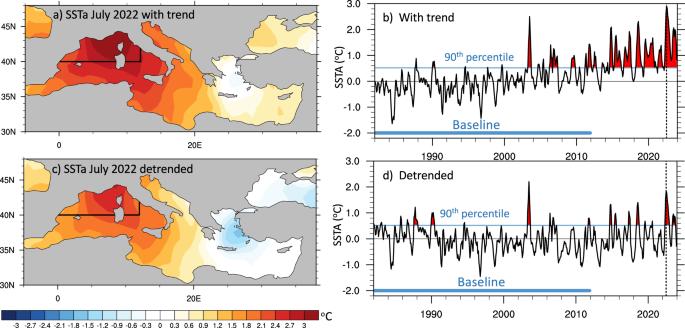不断变化的气候中的海洋热浪全球概览
IF 8.1
1区 地球科学
Q1 ENVIRONMENTAL SCIENCES
引用次数: 0
摘要
海洋热浪对世界海洋大片区域的海洋生态系统产生了深远影响,因此需要更好地了解其动态和可预测性。在此,我们认真回顾了这一活跃研究领域最近取得的实质性进展,包括探索这些极端现象的三维结构和演变、其驱动因素、与海洋和陆地上其他极端现象的联系、未来预测以及对其可预测性和当前预测技能的评估。为了在预测和预报海洋热浪及其影响方面取得进展,需要对整个海洋深度和相关时空尺度上的这些极端现象有更全面的机理认识,同时还需要能在这些尺度上真实捕捉主导机理的模式。持续的观测系统以及可快速部署的测量平台,对于实现全面的事件特征描述,同时记录这些极端事件的演变性质及其在不断变化的气候中的影响至关重要。根据广泛的文献综述,要更好地了解海洋热浪的可预测性及其影响,需要在整个海洋深度对这些极端事件进行分析,并利用模型和观测在相关尺度上捕捉其关键驱动因素。本文章由计算机程序翻译,如有差异,请以英文原文为准。

A global overview of marine heatwaves in a changing climate
Marine heatwaves have profoundly impacted marine ecosystems over large areas of the world oceans, calling for improved understanding of their dynamics and predictability. Here, we critically review the recent substantial advances in this active area of research, including the exploration of the three-dimensional structure and evolution of these extremes, their drivers, their connection with other extremes in the ocean and over land, future projections, and assessment of their predictability and current prediction skill. To make progress on predicting and projecting marine heatwaves and their impacts, a more complete mechanistic understanding of these extremes over the full ocean depth and at the relevant spatial and temporal scales is needed, together with models that can realistically capture the leading mechanisms at those scales. Sustained observing systems, as well as measuring platforms that can be rapidly deployed, are essential to achieve comprehensive event characterizations while also chronicling the evolving nature of these extremes and their impacts in our changing climate. Improved understanding of marine heatwave predictability and impacts requires analysis of these extremes at full ocean depth, using models and observations capturing their key drivers at the relevant scales, according to a broad literature review.
求助全文
通过发布文献求助,成功后即可免费获取论文全文。
去求助
来源期刊

Communications Earth & Environment
Earth and Planetary Sciences-General Earth and Planetary Sciences
CiteScore
8.60
自引率
2.50%
发文量
269
审稿时长
26 weeks
期刊介绍:
Communications Earth & Environment is an open access journal from Nature Portfolio publishing high-quality research, reviews and commentary in all areas of the Earth, environmental and planetary sciences. Research papers published by the journal represent significant advances that bring new insight to a specialized area in Earth science, planetary science or environmental science.
Communications Earth & Environment has a 2-year impact factor of 7.9 (2022 Journal Citation Reports®). Articles published in the journal in 2022 were downloaded 1,412,858 times. Median time from submission to the first editorial decision is 8 days.
 求助内容:
求助内容: 应助结果提醒方式:
应助结果提醒方式:


